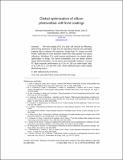Global optimization of silicon photovoltaic cell front coatings
Author(s)
Ghebrebrhan, Michael; Bermel, Peter A.; Joannopoulos, John D.; Johnson, Steven G.; Avniel, Yehuda B.
DownloadJohnson_Global optimization.pdf (4.203Mb)
PUBLISHER_POLICY
Publisher Policy
Article is made available in accordance with the publisher's policy and may be subject to US copyright law. Please refer to the publisher's site for terms of use.
Terms of use
Metadata
Show full item recordAbstract
The front-coating (FC) of a solar cell controls its efficiency, determining admission of light into the absorbing material and potentially trapping light to enhance thin absorbers. Single-layer FC designs are well known, especially for thick absorbers where their only purpose is to reduce reflections. Multilayer FCs could improve performance, but require global optimization to design. For narrow bandwidths, one can always achieve nearly 100% absorption. For the entire solar bandwidth, however, a second FC layer improves performance by 6.1% for 256 μm wafer-based cells, or by 3.6% for 2 μm thin-film cells, while additional layers yield rapidly diminishing returns.
Date issued
2009-04Department
Massachusetts Institute of Technology. Institute for Soldier Nanotechnologies; Massachusetts Institute of Technology. Department of Mathematics; Massachusetts Institute of Technology. Department of PhysicsJournal
Optics Express
Publisher
Optical Society of America
Citation
Ghebrebrhan, Michael, Peter Bermel, Yehuda Avniel, John D. Joannopoulos, and Steven G. Johnson. “Global optimization of silicon photovoltaic cell front coatings.” Optics Express 17, no. 9 (April 22, 2009): 7505. © 2009 Optical Society of America
Version: Final published version
ISSN
1094-4087